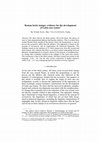Articles by Ville Leppänen

Ancient Greek Linguistics: New Approaches, Insights, Perspectives, 2017
This study presents the evidence that the preserved Gothic documents (most importantly the Bible ... more This study presents the evidence that the preserved Gothic documents (most importantly the Bible translation of Wulfila, fourth century AD) provide for the historical phonology of Greek. The data consist of almost 600 attestations of biblical names and Greek loanwords in the New Testament of the Wulfila Bible (of which approximately 50% has been preserved), including both the Greek originals and their Gothic transcriptions. Provided that the sound value of a Gothic item can be established on the basis of non–Greek evidence (e.g. by way of Gothic internal or historical Germanic considerations), the comparison of the Gothic transcription with the Greek original can be used to infer the sound value of the Greek item. This, in turn, leads to considerations pertaining to the dating and spread of certain sound changes that took place in Greek during the Koine and Byzantine periods. This study complements my previous work (Leppänen 2016), in which the most frequently occurring graphemic correspondences were counted in order
to establish the major trends. Here, however, the data are not amenable to statistical examination due to their scarcity. Most of the findings are in line with previous analyses of Greek historical phonology, while others indicate, for example, that certain vowel changes had not yet taken place by the fourth century AD. This most likely reflects a relatively conservative high-register or ecclesiastic variety used at that time in and
around Constantinople.
Pallas, 2017
In this article 1 we discuss the origin of the genitive singular morpheme -(a)es for -ae in first... more In this article 1 we discuss the origin of the genitive singular morpheme -(a)es for -ae in first declension nouns and its status in the Latin language system. We complement the previous discussion by introducing new data from Roman brick stamps of the first three centuries AD. We base our analysis on the more general metatheoretical framework of linguistic normativity. In this way, we can critically evaluate previous proposals as well as reach, in our view, a better explanation for the appearance and use of this ending.

Glotta, 2016
We show that by the third century AD at the latest, the choice of case in Latin prepositional phr... more We show that by the third century AD at the latest, the choice of case in Latin prepositional phrases had become arbitrary. This is evident from certain Roman brick stamps of the period, where the prepositions ex and de govern the accusative rather than the ablative. Our approach is based on the concept of normativity and its implications for historical linguistics. The findings, based on the analysis of 21 brick stamp texts from the second and third century AD, indicate that there is no direct causal relationship between phonetic, morphological or syntactic factors in the process of morphosyntac-tic change that eventually resulted in the collapse of the Latin case system. The conclusion is that in the third century AD there existed two norms in the language: ex/de…ABL was the only correct expression in higher registers, while ex/de…ACC was widespread and less incorrect in lower registers.

Journal of Historical Linguistics, 2016
The Gothic Bible offers valuable secondary evidence for the pronunciation of Greek in the fourth ... more The Gothic Bible offers valuable secondary evidence for the pronunciation of Greek in the fourth century AD. However, inferences based on such data may result in a vicious circle, as the interpretation of Gothic is, to a great extent, dependent on the historical details of contemporary Greek. I show that a circular argument can be avoided by using a novel method, which is based on the comparison of transcription correspondences of Greek loan words and biblical names occurring in the Greek original and the Gothic version. I test the method by applying it to three example cases. The first concerns the aspirated stops φ, θ, χ: Gothic evidence confirms the fricativization of these stops. The second case concerns the potential fricativization of voiced stops β, δ, γ: the results are inconclusive, which is an important finding, since this shows that Gothic cannot be used as evidence for the fricativization of these stops. The third case concerns front vowels: Gothic evidence confirms the coalescence of αι and ε on the one hand, and ει and ῑ on the other, while it also indicates that η was not (yet) pronounced as [iː] in the fourth century AD.
Presentations by Ville Leppänen
Extended handout of a paper presented at the IG/SIG Conference in Verona, October 2017
Paper presented at MYK XXV colloquium, University of Turku, Finland, 22 September 2017
Book Reviews by Ville Leppänen
Review on: Liebermann, Bianca 2016. Lateinische Präpositionen: Verortung und Valenz (Studienbüche... more Review on: Liebermann, Bianca 2016. Lateinische Präpositionen: Verortung und Valenz (Studienbücher zur lateinischen Linguistik 1). Hamburg: Buske.
Bryn Mawr Classical Review.
Review of: Lehmann, Christian. 2015. Thoughts on grammaticalization. 3rd ed. Berlin: Language Sci... more Review of: Lehmann, Christian. 2015. Thoughts on grammaticalization. 3rd ed. Berlin: Language Science Press.
Review of: Givón, T. 2015. The Diachrony of Grammar. Amsterdam: Benjamins.
Review of: Horrocks, Geoffrey. 2010. Greek: A History of the Language and its Speakers. 2nd ed. C... more Review of: Horrocks, Geoffrey. 2010. Greek: A History of the Language and its Speakers. 2nd ed. Chichester: Wiley-Blackwell.
Theses by Ville Leppänen
Ein deutschsprachiges Exposé meiner Masterarbeit.
Unpublished MA thesis: "Litteris commutatis - Historical linguistics in Varronian etymology", Uni... more Unpublished MA thesis: "Litteris commutatis - Historical linguistics in Varronian etymology", University of Turku, Department of Classics.
Translations by Ville Leppänen
Latin translation of "The Black Cat" by Edgar Allan Poe.
Papers by Ville Leppänen
Cotticelli Kurras, Paola and Sabine Ziegler (eds.), Tra semantica e sintassi: il ruolo della linguistica storica. Zwischen Semantik und Syntax: Die Rolle der historischen Sprachwissenschaft, Roma, 2019
The aim of this paper is to apply the parameters semanticity, bondedness and syntagmatic variabil... more The aim of this paper is to apply the parameters semanticity, bondedness and syntagmatic variability as laid out in Lehmann (2015) to measure the grammaticalization of spatial expressions in Old Hittite, Vedic Sanskrit, Homeric Greek, Latin, Umbrian, and Tocharian.











Uploads
Articles by Ville Leppänen
to establish the major trends. Here, however, the data are not amenable to statistical examination due to their scarcity. Most of the findings are in line with previous analyses of Greek historical phonology, while others indicate, for example, that certain vowel changes had not yet taken place by the fourth century AD. This most likely reflects a relatively conservative high-register or ecclesiastic variety used at that time in and
around Constantinople.
Presentations by Ville Leppänen
Book Reviews by Ville Leppänen
Bryn Mawr Classical Review.
Theses by Ville Leppänen
Translations by Ville Leppänen
Papers by Ville Leppänen
to establish the major trends. Here, however, the data are not amenable to statistical examination due to their scarcity. Most of the findings are in line with previous analyses of Greek historical phonology, while others indicate, for example, that certain vowel changes had not yet taken place by the fourth century AD. This most likely reflects a relatively conservative high-register or ecclesiastic variety used at that time in and
around Constantinople.
Bryn Mawr Classical Review.